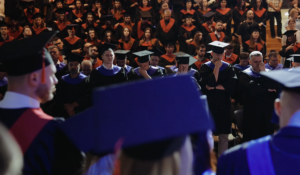
LOUISVILLE, Ky. (BP)–In a region of Indonesia devastated by last December’s tsunami, Kenneth Magnuson saw “a few places near the ocean that were completely decimated, where every home was wiped off the face of the earth — except for an occasional wall or two that was left standing.
“And we were told it was like that for something like 200 miles down the coast,” said Magnuson, associate professor of Christian ethics at Southern Baptist Theological Seminary, who was among a group 11 students, faculty members and spouses who worked in post-tsunami relief March 30-April 11 in one of the areas hardest hit by the devastating earthquake and tsunami that struck southern Asia Dec. 26.
“Thousands of wells were filled with salt water. Rice fields were completely destroyed. We drove by a mass grave where 47,000 people were buried in a field the size of a football field,” Magnuson recounted.
The seminary group undertook a variety of service projects, including teaching English, surveying disaster sites, talking with local residents and restoring wells to a usable condition.
Because of the tremendous need for fresh water, local residents frequently called on the team to pump out wells. Four members of the team — Magnuson, fellow professors Brad Waggoner and George Martin and master of divinity student Jeff Masengale — made clearing wells one of their primary activities.
“People would see us and come from all around to ask if we could pump their well, hoping to restore fresh water,” Magnuson said. “They would express great appreciation for doing that and often would offer something to drink, giving us an opportunity to receive their hospitality and to talk with them.”
Waggoner, who serves as dean of Southern Seminary’s school of leadership and church ministry, said the Indonesian people were “very friendly, warm and appreciative of our efforts to help them.”
“I was expecting some anti-Western and anti-Christian hostility, but I never sensed that at all,” Waggoner said. “Most people smiled at us and treated us with great respect.”
David Sills, director of Southern’s Great Commission Center and associate professor of missions and cultural anthropology, said the trip was an opportunity for a broad spectrum of students and faculty to declare God’s glory to the tsunami-affected areas.
“This Indonesia trip was planned immediately following the devastating tsunami of Dec. 26, 2004, so that faculty and students from all areas of Southern Seminary could put their faith into action and demonstrate the love of Christ to hurting people,” Sills said. “The trip was rewarding labor for the participants, needed relief to the recipients and a blessing to all by His grace and for His glory.”
Taking international mission trips such as this one is a natural outgrowth of the priority Southern places on missions and evangelism, Sills noted.
“We are focused on mobilizing Christ’s church to reach the world for His glory,” he said. “We strive to do this by leading students to a thorough consideration of the claims of international missions upon them personally as a lifework.”
One student who participated in the trip said serving tsunami victims opened doors to speak a message of hope to people in the region.
“Every person we met had stories of family members and friends who died in the earthquake or the tsunami, and I am so thankful that we were able to go there for such a time as this,” said Linda Clark*. “God opened the door a couple of times for us to share truth in love with people that we befriended, and they were very open and curious about what we believed. Being able to meet some of their physical needs also allowed us the opportunity to demonstrate His love for them in a very practical way.
“The needs there are great and the task is bigger than I imagined before seeing this area with my own eyes. I definitely believe that the coming months and years of relief work and recovery following the tsunami will have a significant impact on the spiritual climate of Indonesia.”
Waggoner noted that rebuilding efforts lag far behind what he expected before arriving in Southeast. “We saw some temporary housing shelters, but I was expecting to see a lot more,” he said.
Magnuson said the trip opened his eyes to the need for continuing relief efforts in the region for years to come.
“The devastation that remains is almost incomprehensible and is pretty close to the devastation immediately after the tsunami,” Magnuson said. “Some work has been done, and medical clinics have helped a lot of people, and survivors have begun to rebuild their lives and pick up the pieces. But the rebuilding work is not something that will be completed in a month. This is going to be years, and even decades.”
–30–
Name changed for security reasons.










